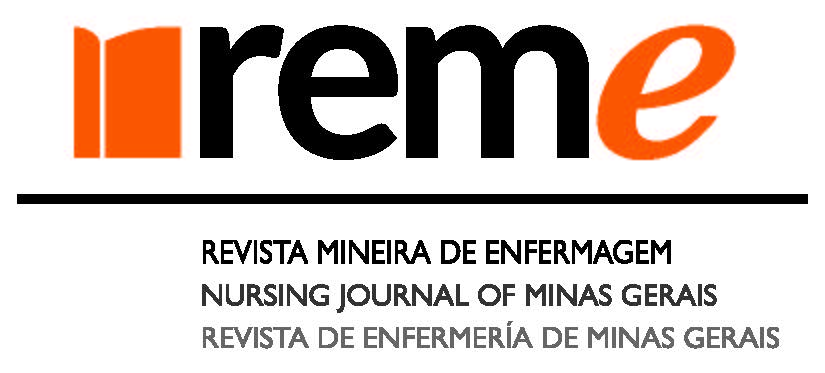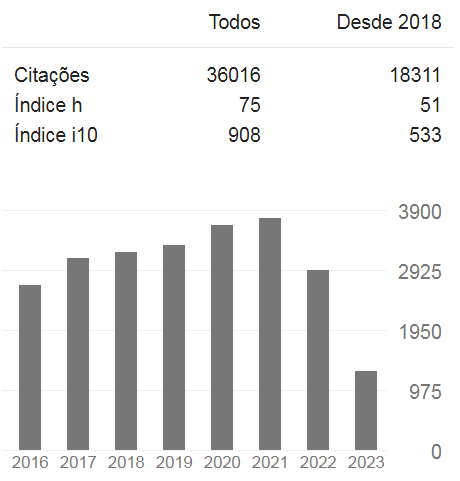Challenges and possibilities of co-participation of the puerperal woman and the companion in safe care
DOI:
https://doi.org/10.35699/reme.v27i.38840Keywords:
Patient Safety, Patient Participation, Maternity, Family, Medical ChaperonesAbstract
Objective: to identify the challenges and possibilities of co-participation of puerperal women and companions in safe maternity care. Materials and Methods: qualitative study carried out with 23 mothers and 11 companions in a maternity hospital in Belo Horizonte, between March and July 2019. Data were collected through interviews with semi-structured scripts and submitted to thematic content analysis, according to the theoretical framework of patient safety. Results: two categories emerged: contribution of the puerperal woman and the companion for safe care; and challenges and contributions to achieving co-participation of puerperal women and companions in patient safety. Conclusions: companions and puerperal women recognize themselves as co-participants in promoting patient safety, however, a lack of knowledge and encouragement regarding the participation of these actors was observed. The importance of using educational technologies to include them as active partners in patient safety is highlighted.
Downloads
References
Word Health Organization. Patient safety - a global priority. Bull World Health Organ [Internet]. Geneva; 2004[citado em 2021 abr. 24];82(12):891-970. Disponível em: https://www.who.int/publications/journals/bulletin
Ministério da Saúde (BR). Portaria nº 529 de 1º de abril de 2013. Institui o Programa Nacional de Segurança do Paciente (PNSP) [Internet]. Brasília; 2013[citado em 2021 abr. 21]. Disponível em: https://bvsms.saude.gov.br/bvs/saudelegis/gm/2013/prt0529_01_04_2013.html
Agência Nacional de Vigilância Sanitária. Resolução RDC nº 36 de 25 de julho de 2013. Institui ações para a segurança do paciente em serviços de saúde e dá outras providências [Internet]. Brasília: ANVS; 2013[citado em 2021 abr. 21]. Disponível em: https://bvsms.saude.gov.br/bvs/saudelegis/anvisa/2013/rdc0036_25_07_2013.html
Ministério da Saúde (BR). DATASUS - Sistema de Informações sobre Nascidos Vivos (SINASC) [Internet]. Brasília: MS; 2018[citado em 2021 abr. 21]. Disponível em: http://tabnet.datasus.gov.br/cgi/deftohtm.exe?sinasc/cnv/nvuf.def
Ministério da Saúde (BR). Boletim Epidemiológico n°20 - Mortalidade materna no Brasil [Internet]. Brasília: MS; 2020[citado em 2021 abr. 26]. Disponível em: https://portaldeboaspraticas.iff.fiocruz.br/atencao-mulher/mortalidade-materna-no-brasil-boletim-epidemiologico-n-o-20-ms-maio-2020/
Neiva LEC, Barros AF, Imoto AM, Gottems LBD. Reported incidents in obstetric care of a public hospital and associated factors. Vigil Sanit Debate [Internet]. 2019[citado em 2021 maio 21];7(4):54-60. Disponível em: https://doi.org/10.22239/2317-269x.01324
Ministério da Saúde (BR). Agência Nacional de Vigilância Sanitária. Serviços de atenção materna e neonatal: segurança e qualidade/Agência Nacional de Vigilância Sanitária [Internet]. Brasília: MS; 2014[citado em 2021 abr. 10]. Disponível em: https://proqualis.net/sites/proqualis.net/files/Servi%C3%A7os%20de%20Aten%C3%A7%C3%A3o%20Materna%20e%20Neonatal%20-%20Seguran%C3%A7a%20e%20Qualidade.pdf
Ministério da Saúde (BR). Agência Nacional de Vigilância Sanitária. Pacientes pela segurança do paciente em serviços de saúde: como posso contribuir para aumentar a segurança do paciente? Orientações aos pacientes, familiares e acompanhantes [Internet]. Brasília: MS; 2017[citado em 2021 abr. 12]. Disponível em: https://segurancadopaciente.com.br/wp-content/uploads/2017/08/GUIA_SEGURANA_PACIENTE_ATUALIZADA-1.pdf
Souliotis K, Agapidaki E, Peppou LE, Tzavara C, Varvaras D. Original Article Assessing Patient Organization Participation in Health Policy: a comparative study in France and Italy. Kerman Univ Med Sci [Internet]. 2018[citado em 2021 abr 20];7(1):48-58. Disponível em: https://pubmed.ncbi.nlm.nih.gov/29325402/
Costa DG, Moura GMSS, Pasin SS, Costa FG, Magalhães AMMM. Patient experience in co-production of care: perceptions about patient safety protocols. Rev Latinoam Enferm [Internet]. 2020[citado em 2021 maio 21];28:e3272. Disponível em: https://doi.org/10.1590/1518-8345.3352.3272
Sousa FCP, Montenegro LC, Goveia VR, Corrêa AR, Rocha PK, Manzo BF. Family participation in patient safety in neonatal units from the nursing perspective. Texto & Contexto Enferm [Internet]. 2017[citado em 2021 maio 21];26(3):e1180016. Disponível em: https://doi.org/10.1590/0104-07072017001180016.
Gonçalves KMM, Costa MTTCA, Silva DCB, Baggio ME, Corrêa AR, Manzo BF. Ludic strategy for promoting engagement of parents and caregivers in the safety of pediatric patients. Rev Gaúch Enferm [Internet]. 2020[citado em 2021 maio 21];41:e20190473. Disponível em: https://doi.org/10.1590/1983-1447.2020.20190473
Minayo MCS. Sampling and saturation in qualitative research: consensuses and controversies. Rev Pesquisa Qualitativa [Internet]. 2017[citado em 2021 abr. 23];5(7):1-12. Disponível em: https://editora.sepq.org.br/rpq/article/view/82
Nascimento LCN, Souza TV, Oliveira ICS, Moraes JRMM, Aguiar RCB, Silva LF. Theoretical saturation in qualitative research: an experience report in interview with schoolchildren. Rev Bras Enferm [Internet]. 2018[citado em 2021 abr. 23];71(1):228-33. Disponível em: https://doi.org/10.1590/0034-7167-2016-0616
Elo S, Kääriäinen M, Kanste O, Pölkk T, Utriainen K, Kyngäs H. Qualitative content analysis: a focus on trustworthiness. Sage Open [Internet]. 2014[citado em 2021 maio 21];4(1):1-10. Disponível em: https://doi.org/10.1177/2158244014522633
Ricci-Cabello I, Pons-Vigués M, Berenguera A, Pujol-Ribera E, Slight SP, Valderas JM. Patients’ perceptions and experiences of patient safety in primary care in England. Fam Pract [Internet]. 2016[citado em 2021 maio 21];33(5):535-42. Disponível em: https://pubmed.ncbi.nlm.nih.gov/27312563/
Souza HX, Almeida ABAS, Dantas LV, Brito Paranaguá TT. Surgical patients’ perception of safety and their involvement in health care. Rev Enferm UERJ [Internet]. 2020[citado em 2021 maio 21]; 28:e51498. Disponível em: https://doi.org/10.12957/reuerj.2020.51948
Pomey, MP, Clavel, N, Aho-Glele U, Ferré N, Fernandez PM. How patients view their contribution as partners in the enhancement of patient safety in clinical care. J Patient Exp [Internet]. 2018[citado em 2021 maio 20];5(1):35-49. Disponível em: https://doi.org/10.35680/2372-0247.1235
Sendlhofer G, Pregarther G, Leitgeb K, Hoffmann M, Berghold A, Smolle C, et al. Results of a population-based-assessment: we need better communication and more profound patient involvement. Wien Klin Wochenschr [Internet]. 2017[citado em 2021 maio 22];129:269-77. Disponível em: https://doi.org/10.1007/s00508-016-1165-8
Register SJ, Blanchard E, Belle A, Viles A, Moore SP, MacLennan P,White ML. Using AIDET education simulations to improve patient experience scores. Clin Simul Nurs [Internet]. 2020[citado em 2021 jun. 21];38(C):14-7. Disponível em: https://doi.org/10.1016/j.ecns.2019.09.005
Silva RSS, Rocha SS, Gouveia MTO, Dantas ALB, Santos JDM, Carvalho NAR. Wearing identification wristbands: implications for newborn safety in maternity hospitals. Esc Anna Nery Rev Enferm [Internet]. 2019[citado em 2021 jun. 21];23(2):e20180222. Disponível em: https://doi.org/10.1590/2177-9465-ean-2018-0222
Khan A, Spector ND, Baird JD, Ashland M, Starmer AJ, Rosenbluth G, et al. Patient safety after implementation of a coproduced family centered communication programme: multicenter before and after intervention study. BMJ [Internet]. 2018[citado em 2021 jun. 21];363:1-17. Disponível em: https://doi.org/10.1136/bmj.k4764
Additional Files
Published
How to Cite
Issue
Section
License
Copyright (c) 2023 REME-Revista Mineira de Enfermagem

This work is licensed under a Creative Commons Attribution 4.0 International License.






































